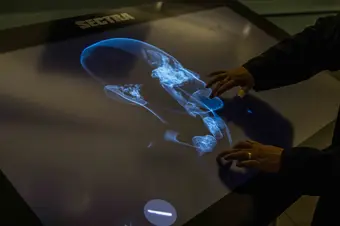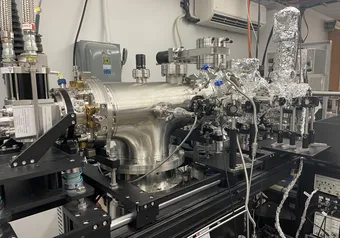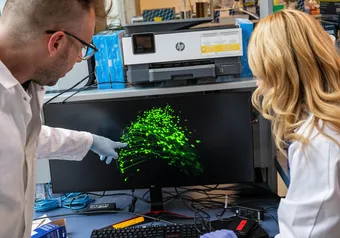Deep in the basement of the Life Science Centre, in the first-year medical school lab that is full of body bags and cadavers, lives the anatomy visualization table — a giant iPad like device stuffed full of medical data.
“It’s like a giant iPad that you can load CT data on,” explained Claudia Krebs, a professor teaching in the department of cellular and physiological sciences who is using the device to teach her students. “It does 3D reconstructions of [CT scans] that you can then rotate and manipulate. You can cut through them, change the opacity to see different structures like bones or go all the way to the skin level.”
The UBC medical school, which revamped its entire curriculum two years ago, sees the 500 pound device as an important teaching tool in anatomy and radiology — the branch of medicine that deals with medical imaging. The “giant iPad” (it’s playful name even though it runs windows and isn't made by Apple) will be used in conjunction with cadavers.
The new curriculum is “case-based,” according to Krebs. That means each week, medical students are introduced to a case which they work through in lectures, presentations, small-group work, dissections and now the anatomy visualization table.
[Sorry, video not found. You can contact webmaster@ubyssey.ca to fix the issue]
“The strength of it is that we can use real patient data that we can reconstruct and work with. You can put three dimensional labels on there, so a lot of dynamics we can do,” said Krebs. She envisions students working cooperatively on the table, quizzing themselves on it and even, one day, practicing procedures on it.
The device also marks a new stage in cooperation between anatomy and radiology, which have had a historically close relationship. Krebs thinks the “giant iPad” will better teach students how to translate imaging from radiology to real life — something she said they usually struggle with.
“The translation from the real to the digital and back again will just become intuitive,” Krebs explained.
Why not just use normal-sized iPads? “You can have the anatomy life-sized, you can have it larger than life and more importantly, you can collaborate on it,” said Krebs.
The device, made by the Swedish company Sectra, cost around $190,000, according to Krebs. The London Drugs Foundations bought the device for the med school and will pay for the first year of the service contract which is a whopping $19,000 a year. And you thought your cellphone bill was expensive.
“We want to see if this investment has an impact on student learning,” said Krebs. She explained that the med school will do the first rigorous research on how the device affects learning to see if — and how — it improves learning. When they get the results from the study, the school may purchase more to use in other settings and to teach other health care professionals.
“I was the biggest skeptic of this project before we started it,” said Krebs. It was talking to students in Sweden, she explained, and seeing how they benefited from it, that changed her mind.
Unfortunately for you, the device will only be used to teach first year medical students. You’ll just have to deal with your giant iPhone for now.
First online
Share this article








